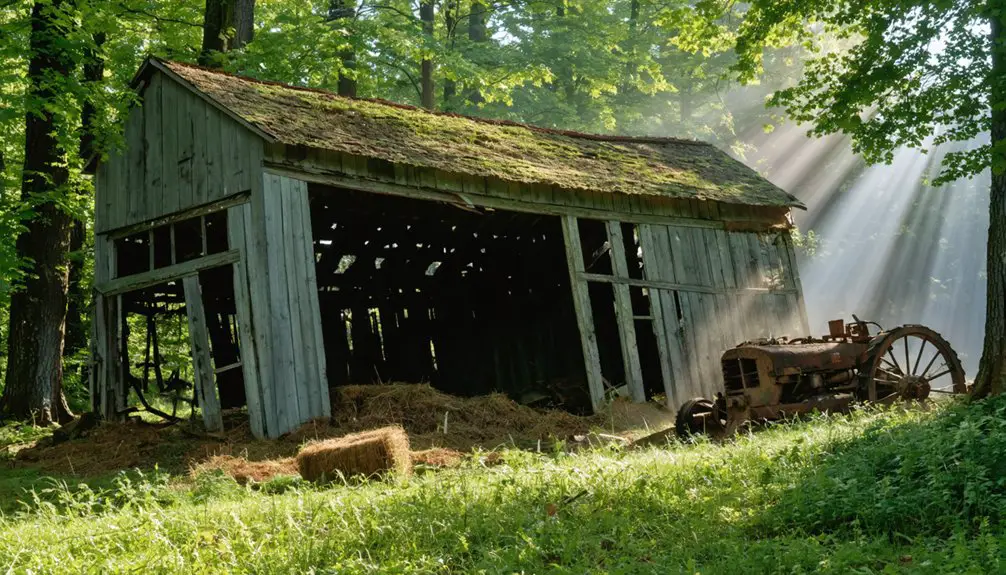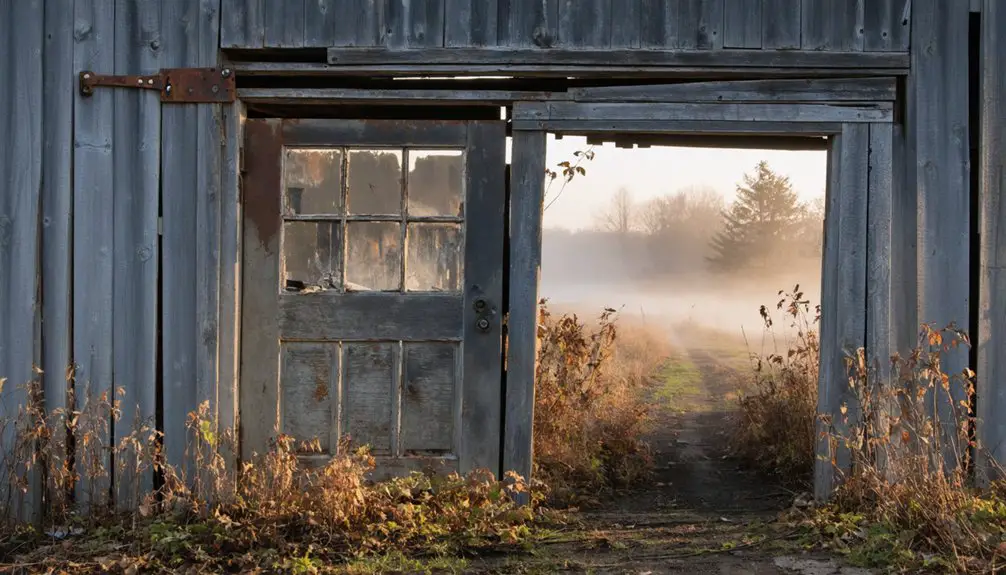You’ll discover Wenlock tucked away in Essex County’s northeastern corner of Vermont, where pioneer families once carved homesteads from dense boreal forest. The ghost town‘s stone walls and cellar holes tell tales of hardy settlers who built a thriving community in the late 1700s, only to see it fade by the 1930s due to harsh farming conditions and economic hardship. Today, nature’s reclaimed the landscape, but mysterious legends and unexplained phenomena keep Wenlock’s spirit alive.
Key Takeaways
- Wenlock is an abandoned Vermont town in Essex County, marked by remnants of stone walls, cellar holes, and old railroad beds.
- Economic decline in the 1930s, including falling milk prices and factory closures, forced many residents to abandon their farms and homes.
- The town’s population dropped significantly from 23 residents in 1830, eventually becoming completely deserted due to harsh farming conditions.
- Extensive logging operations stripped the area’s old-growth forests by 1920, causing environmental damage and contributing to the town’s abandonment.
- Local legends and supernatural phenomena, including unexplained lights and sounds, make Wenlock part of Vermont’s ghostly folklore.
Historical Location and Geography
Tucked away in Essex County’s northeastern corner, Wenlock stands as a tribute to Vermont’s logging heritage. You’ll find this historical ghost town nestled in boreal forest at elevations between 1,140 and 1,200 feet, surrounded by spruce and fir trees that whisper tales of its past.
The geographical features that once made Wenlock ideal for logging operations remain – you’re in the heart of the Nulhegan River basin, where the landscape showcases extensive northern wetlands and old-growth timber stands. Much like the dense tree cover that has complicated search efforts in the Bennington Triangle, the thick forest canopy here creates an almost impenetrable wilderness. Similar to the Slate History Trail, the area preserves significant historical landmarks of Vermont’s industrial past.
The town’s historical significance is etched into the land itself, where you can still trace the old Canadian National Railroad beds and discover remnants of what was once one of Vermont’s busiest timber sidings.
Nature’s now reclaiming these marks of human industry, as the wilderness slowly embraces Wenlock’s logging legacy.
Settlers and Early Communities
Early Wenlock’s pioneer families staked their claims along fertile valleys and near resource-rich areas, where they’d build modest homesteads marked by stone walls and cellar holes you’ll still find today. Many families engaged in sheep farming activities as evidenced by the remaining stone walls that once enclosed grazing pastures.
Much like the settlers of Ricker Basin, these early homesteaders left behind foundations and cellar holes as evidence of their presence. You’ll recognize these settlers’ resourcefulness in how they established basic trade networks with neighboring communities, often bartering agricultural goods and lumber from their small farms and woodlots.
Your ancestors who lived here would’ve participated in a close-knit community where families shared labor during harvests and supported local commerce through small general stores and sawmills.
Pioneer Families and Homesteads
During the late 1700s, pioneer families from Connecticut and New York ventured north to Vermont’s untamed wilderness, seeking affordable land to establish their homesteads.
You’ll find these hardy settlers faced tremendous pioneer hardships as they carved out 100+ acre plots from dense forest, often working for established farmers before claiming their own land. They’d build crude shelters first, gradually improving their homes as they cleared more land.
Their homestead innovations included cooperative land-clearing efforts with neighbors and partnerships with local businessmen like Eben Judd, who financed supplies and labor.
You can trace how these families, including the Stories – Amos and Solomon – sustained themselves through farming, raising livestock, and participating in local trade.
Many of their descendants maintained these family properties through generations, solidifying their roots in Vermont’s soil.
Early Commerce and Trade
As settlers arrived, barter systems emerged through general stores where your ancestors might’ve exchanged homemade goods for essentials.
Local mills became essential hubs – you’d find John Johnson’s gristmills employing dozens of men by 1819.
Indigenous craftspeople sold ash splint baskets in these same stores, while the Norton family’s “Bennington Pottery” provided much-needed stoneware containers.
These commerce patterns shaped early Vermont’s rural economy, proving frontier families weren’t as self-sufficient as legend suggests.
Merchants utilized surviving ledger books to track credit transactions before stable currency was established.
The population surge from 300 to 85,000 between 1763 and 1791 created unprecedented demand for trading posts and mercantile establishments.
Economic Rise and Development
Wenlock’s economic foundation rested on limited natural resources, with its high elevation restricting agricultural possibilities that many Vermont towns relied upon for sustenance.
Like Glastenbury’s peak workforce engaged in charcoal-making and logging, small mountain communities often depended heavily on forest-based industries.
You’ll find that timber harvesting from the surrounding forests formed the backbone of early resource management efforts, though this wasn’t enough to guarantee economic sustainability.
With just 23 residents recorded in 1830, the town’s tiny population couldn’t support diverse commercial ventures or attract substantial investment.
While some Vermont ghost towns flourished briefly through mining or spa tourism, Wenlock never developed such economic drivers.
The lack of fertile soil and limited infrastructure made it tough for families to put down lasting roots, and without a robust economic base to build upon, the town’s prospects for growth remained constrained throughout the 1830s when other areas of Vermont were experiencing a surge of utopian communities.
Transportation and Infrastructure
Transportation posed significant challenges in this remote mountain settlement. When Wenlock’s copper mines bustled with activity, you’d have seen about six miles of underground shafts where miners extracted valuable ore.
Railroad expansion eventually reached the area, making it easier to move heavy materials and connect to broader markets, though specific details of these rail lines haven’t survived in records.
The arrival of railways transformed isolated mining towns, though time has erased many details of these vital transportation links.
While the town likely maintained basic water management for its mining operations, there’s no evidence of elaborate aqueduct systems like those found in other Vermont villages of the era.
You’ll still find remnants of old dynamite storage buildings and mining facilities scattered about, though they’re dangerous to explore now. The infrastructure that once supported this thriving community gradually fell into disuse as mining operations declined. These dangerous conditions were common, as miners worked without any workplace safety protocols, using cotton to protect their ears from the constant drilling noise.
Decline and Abandonment

Wenlock’s decline stemmed from intertwined economic and environmental pressures, as you’ll find that its mountainous terrain made farming nearly impossible while offering no viable alternatives for local industry.
From its meager population of 23 in 1830, you can trace how families gradually moved away over generations, with younger folks seeking better opportunities in more accessible towns.
Today, the abandoned town stands as a symbol to Vermont’s changing rural landscape, where Mother Nature has largely reclaimed the limited infrastructure and farmland that once supported this small mountain community. The area is now part of the Silvio O. Conte Refuge, preserving what remains of the historic Wenlock Woods.
Economic Factors Behind Exodus
As Vermont’s agricultural fortunes plummeted in the early 1930s, Wenlock faced a devastating economic storm that would ultimately seal its fate.
When milk prices crashed below production costs and over 1,500 farms shut down across the state, you’d have seen families packing up their belongings as economic instability drove them from their homesteads.
The town’s heavy reliance on resource extraction proved especially damaging – like many Northeast Kingdom communities, Wenlock couldn’t survive the boom-and-bust cycles of logging and mining.
Rural migration accelerated as industrial jobs vanished, with factory employment plunging 45% statewide.
Your ancestors would’ve watched helplessly as their neighbors left one by one, until Wenlock’s limited economy simply couldn’t sustain what remained of the community.
Population Decline Timeline
Like many Vermont settlements, Wenlock followed a predictable pattern of growth and decline that you’d recognize from similar ghost towns across the Northeast Kingdom.
You’ll see familiar community evolution in Wenlock’s timeline – early 1800s growth fueled by logging and farming families settling the land, followed by a steady population through the mid-1800s when local industries thrived.
But by the late 1800s, you’d notice the start of population migration as exhausted timber resources and changing transportation routes pulled folks away.
The real exodus hit in the early 1900s when floods and economic troubles drove more families out.
Environmental Impact Today
The environmental scars of Wenlock’s decline run deeper than abandoned buildings and overgrown fields. You’ll find the legacy of extensive logging written in the land itself, where nearly all old-growth forests were stripped away by 1920.
Though nature’s trying to heal through ecological restoration, the damage from those logging days persists in eroded soils and altered waterways.
The forest biodiversity you’d have seen in Wenlock’s early days is dramatically different now. The wolves and lynx are long gone, and the secondary forests lack the rich complexity of their predecessors.
When you walk the old railroad beds today, you’ll notice how they wash out during floods, sending sediment downstream. Even as the trees return, they’re fighting modern threats like acid rain and pollution, making full recovery a distant dream.
Natural Reclamation and Present State
Since being abandoned, Wenlock’s remnants have surrendered to nature’s relentless reclamation, with dense Vermont woods now dominating what once stood as a bustling settlement.
The natural resurgence has transformed collapsed roofs and crumbling foundations into havens for wildlife, while seasonal changes drive an ongoing ecological transformation.
Through nature’s patient work, you’ll find streams carving new paths where streets once lay, and wetlands emerging in forgotten foundations.
- Wild creatures have reclaimed the town’s shell, with birds nesting in deteriorated rafters and mammals sheltering in overgrown cellars.
- Native ferns, brambles, and saplings burst through floorboards and wind through old stone walls.
- Vermont’s harsh weather cycles steadily dissolve remaining structures into the forest floor.
- Former roadways have disappeared beneath thick moss and persistent underbrush.
Local Legends and Cultural Impact
Beyond its physical decay, Wenlock harbors a rich tapestry of supernatural tales that intertwine with Vermont’s broader folklore.
You’ll find accounts of legendary creatures prowling the dense woods, passed down from both settlers and Indigenous tribes who once called these lands home. The town’s mysterious past, marked by unexplained lights and haunting sounds, has become part of the infamous Bennington Triangle’s supernatural phenomena.
The ghostly narratives haven’t just preserved local history – they’ve shaped Vermont’s cultural folklore.
Through regional mysteries and storytelling traditions, Wenlock’s legends live on in works like Shirley Jackson’s “Hangsaman” and countless local tales. These stories don’t just entertain; they’re keeping alive the memory of vanished communities and serving as powerful reminders of the Green Mountains’ untamed spirit.
Frequently Asked Questions
Are There Any Remaining Structures or Ruins Still Visible in Wenlock Today?
You won’t find documented architectural remnants or historic preservation efforts there today, as research and field reports haven’t confirmed any surviving structures in this remote location’s landscape.
What Happened to the Last Residents Who Lived in Wenlock?
While some last families endured harsh isolation, they eventually joined the migration to bustling towns. During the final years, you’d have found them seeking better opportunities in Vermont’s growing cities.
Can Visitors Legally Explore the Former Town Site of Wenlock?
You’ll need explicit landowner permission before exploring this ghost town, as there aren’t public access regulations in place. For your safety, it’s currently considered private property requiring authorization.
Were Any Notable Crimes or Mysterious Incidents Reported in Wenlock?
Despite local interest in unexplained disappearances and legends across Vermont’s ghost towns, you won’t find any documented mysterious incidents or crimes in Wenlock’s history – it’s simply a quietly abandoned mountain settlement.
What Natural Resources Originally Attracted Settlers to the Wenlock Area?
You’ll find that massive timber resources were the primary draw, with rich forests of spruce and fir. The rivers and wetlands offered fishing and hunting, though there weren’t significant mineral deposits.
References
- https://happyvermont.com/2014/10/23/glastenbury-ghost-town/
- http://freepages.rootsweb.com/~gtusa/history/usa/vt.htm
- https://www.youtube.com/watch?v=ScW-H7A8yL8
- https://en.wikipedia.org/wiki/List_of_ghost_towns_in_Vermont
- https://cather.unl.edu/writings/letters/let0073
- http://anrmaps.vermont.gov/websites/wma/maps/Wenlock.pdf
- http://val.vtecostudies.org/wp-content/uploads/2015/09/TheAtlasofVermontBreedingBirds1985.pdf
- https://digitalvermont.org/index.php/items/show/3891?advanced[][element_id]=49&advanced[][type]=is+exactly&advanced[][terms]=Waterford+(Vt.)–Maps,+Manuscript&sort_field=Dublin+Core,Title&sort_dir=d
- https://vermontcountry.com/2022/09/18/ghost-town/
- https://mysterioushillsdotcom.wordpress.com/2021/02/13/snapshots-of-a-ghost-town-fayville-vt-2004/



